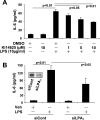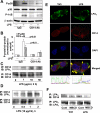Lysophosphatidic acid receptor 1 modulates lipopolysaccharide-induced inflammation in alveolar epithelial cells and murine lungs
- PMID: 21821728
- PMCID: PMC3191756
- DOI: 10.1152/ajplung.00058.2011
Lysophosphatidic acid receptor 1 modulates lipopolysaccharide-induced inflammation in alveolar epithelial cells and murine lungs
Abstract
Lysophosphatidic acid (LPA), a bioactive phospholipid, plays an important role in lung inflammation by inducing the release of chemokines and lipid mediators. Our previous studies have shown that LPA induces the secretion of interleukin-8 and prostaglandin E(2) in lung epithelial cells. Here, we demonstrate that LPA receptors contribute to lipopolysaccharide (LPS)-induced inflammation. Pretreatment with LPA receptor antagonist Ki16425 or downregulation of LPA receptor 1 (LPA(1)) by small-interfering RNA (siRNA) attenuated LPS-induced phosphorylation of p38 MAPK, I-κB kinase, and I-κB in MLE12 epithelial cells. In addition, the blocking of LPA(1) also suppressed LPS-induced IL-6 production. Furthermore, LPS treatment promoted interaction between LPA(1) and CD14, a LPS coreceptor, in a time- and dose-dependent manner. Disruption of lipid rafts attenuated the interaction between LPA(1) and CD14. Mice challenged with LPS increased plasma LPA levels and enhanced expression of LPA receptors in lung tissues. To further investigate the role of LPA receptors in LPS-induced inflammation, wild-type, or LPA(1)-deficient mice, or wild-type mice pretreated with Ki16425 were intratracheally challenged with LPS for 24 h. Knock down or inhibition of LPA(1) decreased LPS-induced IL-6 release in bronchoalveolar lavage (BAL) fluids and infiltration of cells into alveolar space compared with wild-type mice. However, no significant differences in total protein concentration in BAL fluids were observed. These results showed that knock down or inhibition of LPA(1) offered significant protection against LPS-induced lung inflammation but not against pulmonary leak as observed in the murine model for lung injury.
Figures







References
-
- Aoki J, Inoue A, Okudaira S. Two pathways for lysophosphatidic acid production. Biochim Biophys Acta 1781: 513–518, 2008 - PubMed
-
- Bosnar M, Bosnjak B, Cuzic S, Hrvacic B, Marjanovic N, Glojnaric I, Culic O, Parnham MJ, Erakovic Haber V. Azithromycin and clarithromycin inhibit lipopolysaccharide-induced murine pulmonary neutrophilia mainly through effects on macrophage-derived granulocyte-macrophage colony-stimulating factor and interleukin-1beta. J Pharmacol Exp Ther 331: 104–113, 2009 - PubMed
-
- Chaby R, Garcia-Verdugo I, Espinassous Q, Augusto LA. Interactions between LPS and lung surfactant proteins. J Endotox Res 11: 181–185, 2005 - PubMed
Publication types
MeSH terms
Substances
Grants and funding
LinkOut - more resources
Full Text Sources
Molecular Biology Databases
Research Materials
Miscellaneous

